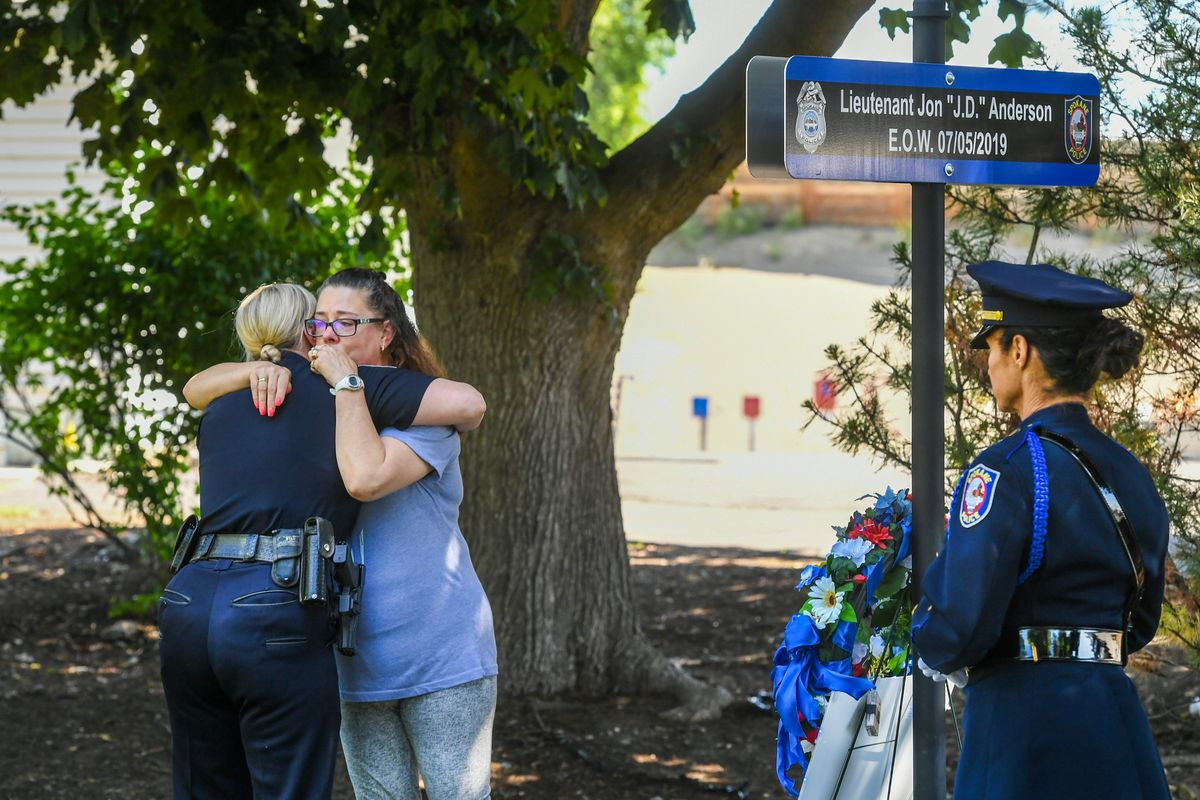Spokane police honor fallen lieutenant after recent line-of-duty designation for his death

Jon “JD” Anderson was the type of person who loved to work, loved to volunteer and loved people, family, friends and former co-workers recalled of the late Spokane Police Department lieutenant during a memorial dedication Tuesday on the third anniversary of his death.
Anderson died at the age of 50 on July 5, 2019, due to complications from a decades-old injury. Although he died at home, his death was officially recognized as a “line of duty” death in December because of the injury.
He had been with the Spokane Police Department for 28 years. Anderson served in a number of roles with the department, but was perhaps best known for his work planning for major city events, such as Hoopfest and Bloomsday.
“Those who knew JD knew he was a force to be reckoned with,” Spokane police Chief Craig Meidl said at the ceremony.
The son of former Spokane police Capt. Dave Anderson, he is survived by his wife, Michelle, and daughter, Jordyn Cranes.
It was an emotional ceremony for the family, who received a dedication marker for Anderson at the Spokane Police Academy on a warm, clear day.
“He was blue through and through,” Michelle Anderson said. “I shared him with the department. He was married to the department as much as he was to me.”
Anderson was just as dedicated as a father as he was a police officer, Cranes said. “Every track meet, every cross country meet,” he was there, she said.
“I had dance shows. He wasn’t that into that,” she said with a laugh “but he’d still show up.”
He was loud and funny, but also organized and always busy with something, Cranes said.
His wife said “he was like a big kid.”
Cranes’ father was the first person she went to when looking for advice on nearly anything.
“My dad was my person. Figuring out life without him here was so hard,” she said.
His passing was made even more difficult because she didn’t know how to navigate her grief without his advice.
“He was the person I wanted to talk to about it the most,” she said. “I was hurting more than anything in my life.”
Cranes is done mourning her father and instead wants to continue honoring him, she said.
Citing the National Institutes of Health, Meidl said police officers, on average, die about 22 years before members of the general public.
“When you look at the national statistics, law enforcement officers have higher statistics of anything negative,” including divorce, depression and cancer, Meidl said. “This job can be a real grind.”
Anderson’s death was the result of a shoulder injury he sustained while on duty in 1997. Anderson underwent five surgeries, but dealt with severe shoulder pain throughout his career, friends and family said. His wife said that he injured the same shoulder again while on duty on a motorcycle in 2014, Michelle Anderson, said.
The pain was so severe that he was often unable to sleep at night.
“The lack of sleep alone was such a huge issue,” Michelle said. “He would just get so frustrated because he couldn’t do a lot of the things he used to enjoy doing. He would sometimes have to prop himself up against the door frame at night to give his back and shoulder some relief.”
Things finally turned around in March 2019 when he went in for surgery, Michelle said.
“He was back to his happy-go-lucky self,” she said.
However, he was taking medication for his surgery that ultimately caused a bleeding ulcer in July that year, which Michelle Anderson suspects led to his death in July.
Although Anderson died in the hospital while he was not working, his death was officially recognized as a “line of duty” death in December 2021 because of the work-related injury.
The fight to get his death recognized as a line of duty death was very difficult, but she said she is glad to have him honored with the designation.
Editor’s note: This story was updated on July 6, 2022, to reflect that Anderson died at a hospital. An earlier version misstated the location of his death.